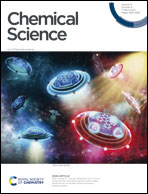Cooperatively assembled liquid crystals enable temperature-controlled Förster resonance energy transfer†
Abstract
Balancing the rigidity of a π-conjugated structure for strong emission and the flexibility of liquid crystals for self-assembly is the key to realizing highly emissive liquid crystals (HELCs). Here we show that (1) integrating organization-induced emission into dual molecular cooperatively-assembled liquid crystals, (2) amplifying mesogens, and (3) elongating the spacer linking the emitter and the mesogen create advanced materials with desired thermal–optical properties. Impressively, assembling the fluorescent acceptor Nile red into its host donor designed according to the aforementioned strategies results in a temperature-controlled Förster resonance energy transfer (FRET) system. Indeed, FRET exhibits strong S-curve dependence as temperature sweeps through the liquid crystal phase transformation. Such thermochromic materials, suitable for dynamic thermo-optical sensing and modulation, are anticipated to unlock new and smart approaches for controlling and directing light in stimuli-responsive devices.



 Please wait while we load your content...
Please wait while we load your content...